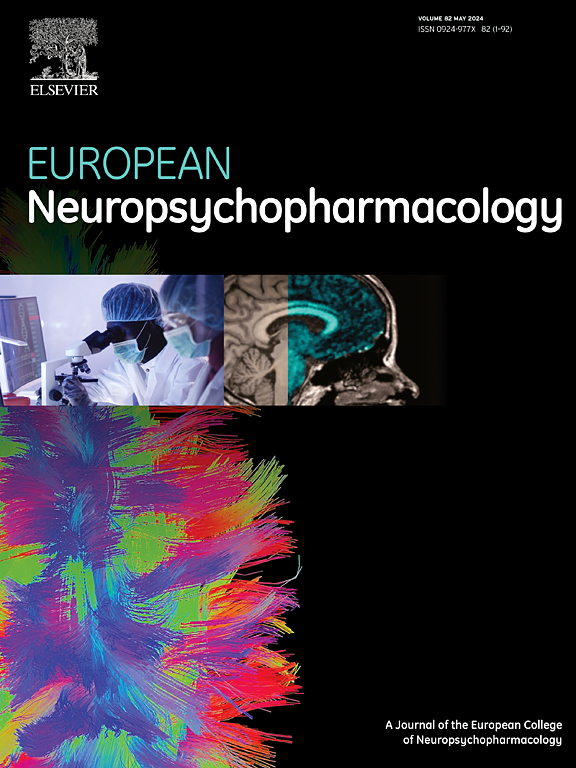DEVELOPMENTAL ORIGINS OF PSYCHIATRIC RISK: DISSECTING GENE REGULATION THROUGH SINGLE-CELL MULTIOMIC ANALYSIS
IF 6.7
2区 医学
Q1 CLINICAL NEUROLOGY
引用次数: 0
Abstract
Psychiatric disorders such as schizophrenia, bipolar disorder, major depression, and autism spectrum disorder frequently originate from disruptions in neurodevelopmental processes, many of which unfold long before clinical symptoms emerge. However, dissecting the molecular and regulatory mechanisms that underlie these early developmental perturbations has remained a major challenge, particularly due to limited access to human brain tissue across the lifespan and the complexity of brain cellular diversity.
To address this, we applied state-of-the-art single-nucleus multi-omic technologies—simultaneously profiling gene expression and chromatin accessibility—to construct high-resolution atlases spanning key stages of human brain development and adulthood. Our datasets encompass over one million nuclei from multiple brain regions, including the dorsolateral prefrontal cortex (DLPFC), a region central to cognition and psychiatric vulnerability, and the olfactory epithelium (OE), a regenerative sensory tissue with neurogenic potential. These integrative datasets enable unprecedented insights into dynamic transcriptional programs and epigenetic regulation during neurodevelopment and aging.
Through trajectory inference and enhancer-gene regulatory network reconstruction, we identified stage-specific transcription factors and cell-type-specific cis-regulatory modules that guide neuronal and glial lineage commitment. We discovered striking convergence in gene regulatory dynamics between olfactory sensory neuron development and early-stage cortical excitatory neurons, suggesting that the OE may serve as a surrogate system to model human neurodevelopment. Furthermore, integrating our regulatory maps with genome-wide association study (GWAS) loci for major psychiatric disorders allowed us to prioritize putative causal genes and regulatory elements operating at specific developmental windows.
Collectively, our findings highlight the power of multiomic single-cell analysis in unraveling the developmental origins of psychiatric disease. By linking genetic risk to temporally defined regulatory programs and accessible cell types, this work lays a foundation for future efforts to pinpoint disease mechanisms and therapeutic targets. Moreover, our demonstration that accessible neurogenic tissues can recapitulate key features of brain development opens new avenues for modeling psychiatric risk in vivo.
精神疾病风险的发育起源:通过单细胞多组学分析剖析基因调控
精神疾病,如精神分裂症、双相情感障碍、重度抑郁症和自闭症谱系障碍,通常源于神经发育过程的中断,其中许多在临床症状出现之前就已经出现了。然而,解剖这些早期发育扰动背后的分子和调控机制仍然是一个主要挑战,特别是由于在整个生命周期中对人类脑组织的访问有限以及脑细胞多样性的复杂性。为了解决这个问题,我们应用了最先进的单核多组学技术——同时分析基因表达和染色质可及性——构建了跨越人类大脑发育和成年期关键阶段的高分辨率图谱。我们的数据集涵盖了来自多个大脑区域的100多万个细胞核,包括背外侧前额叶皮层(DLPFC),一个认知和精神脆弱性的中心区域,以及嗅觉上皮(OE),一个具有神经源性潜力的再生感觉组织。这些综合数据集使我们能够前所未有地深入了解神经发育和衰老过程中的动态转录程序和表观遗传调控。通过轨迹推断和增强基因调控网络重建,我们确定了指导神经元和神经胶质谱系承诺的阶段特异性转录因子和细胞类型特异性顺式调控模块。我们发现嗅觉感觉神经元发育和早期皮层兴奋性神经元之间的基因调控动力学具有显著的趋同性,这表明OE可以作为模拟人类神经发育的替代系统。此外,将我们的调控图谱与主要精神疾病的全基因组关联研究(GWAS)位点相结合,使我们能够优先考虑在特定发育窗口操作的推定因果基因和调控元件。总的来说,我们的发现强调了多组单细胞分析在揭示精神疾病的发育起源方面的力量。通过将遗传风险与暂时定义的调控程序和可获得的细胞类型联系起来,这项工作为未来确定疾病机制和治疗靶点的努力奠定了基础。此外,我们的研究表明,可接近的神经源性组织可以概括大脑发育的关键特征,这为在体内模拟精神疾病风险开辟了新的途径。
本文章由计算机程序翻译,如有差异,请以英文原文为准。
求助全文
约1分钟内获得全文
求助全文
来源期刊

European Neuropsychopharmacology
医学-精神病学
CiteScore
10.30
自引率
5.40%
发文量
730
审稿时长
41 days
期刊介绍:
European Neuropsychopharmacology is the official publication of the European College of Neuropsychopharmacology (ECNP). In accordance with the mission of the College, the journal focuses on clinical and basic science contributions that advance our understanding of brain function and human behaviour and enable translation into improved treatments and enhanced public health impact in psychiatry. Recent years have been characterized by exciting advances in basic knowledge and available experimental techniques in neuroscience and genomics. However, clinical translation of these findings has not been as rapid. The journal aims to narrow this gap by promoting findings that are expected to have a major impact on both our understanding of the biological bases of mental disorders and the development and improvement of treatments, ideally paving the way for prevention and recovery.
 求助内容:
求助内容: 应助结果提醒方式:
应助结果提醒方式:


